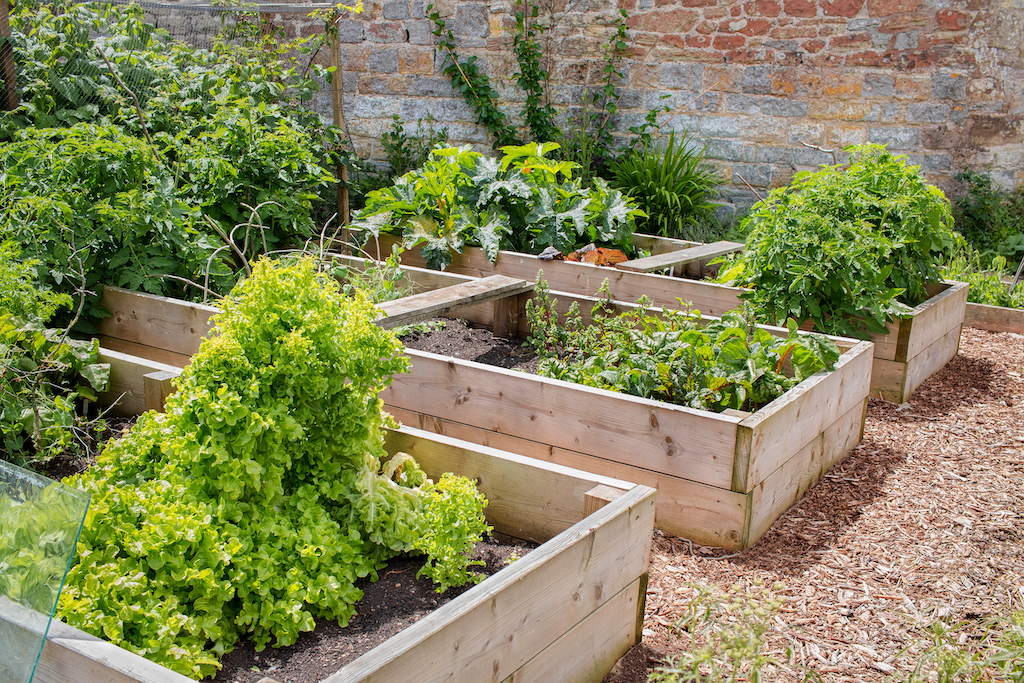Raised bed gardening is popular because it lets you grow your favorite edible or decorative plants practically anywhere. If you live in an area where in-ground soil is unsuitable for planting, this article is for you. Keep reading to learn more about bed gardening.
*This post contains compensated links. Find more info in my DISCLAIMER. As an Amazon Associate, I earn from qualifying purchases.
What Is Raised Bed Gardening
Raised bed gardening is basically a contained bed of soil or mounded soil above the surrounding level. The key aim of raised beds is to create a broad and deep growing area that encourages roots to grow deep and spread. Bed gardening raises the soil surface for your plants, allowing you to overcome most surface challenges.
Raising the soil bed above the surrounding terrain allows you to control its drainage and health. It will enable you to grow productive plants no matter how bad the ground gets.

There are different types of raised garden beds, including:
Raised Ground Beds
These beds are flat-topped soil mounds raised six to eight inches high. They are the simplest form of raised bed gardening, and they don’t require support frames.
Supported Raised Beds
These beds consist of a soil mound surrounded by a frame or supportive edges. They are ideal for uneven or sloped ground.
Containerized Raised Beds
These raised beds are large pots or planters with a base and taller sides. You can place these beds on porches, patios, decks, walkways, and driveways. Though they take more soil, they are versatile.
Why Use A Raised Bed Garden?
Raised gardening beds allow you to control the health of the soil in that you are growing your plants. Elevated bed gardening can put the crops at eye level for easier observation, management, and pest control. You can also contain a raised garden bed within a structure, which allows you to care for your plants without affecting the overall shape of the bed.
Raised beds in gardening are ideal for people with mobility issues because they can work on the plants without bending, squatting, or kneeling. The added convenience makes the work fun, quicker, and easier.
Bed gardening is also ideal for areas where the soil is not suitable for planting or is not deep enough to support plants. You may live in an area with heavy clay, fine-grained sand, hard pack dirt, or your house may be surrounded by rocks or concrete. These factors should not deter you from growing your favorite veggies and herbs. Raised beds for gardening come in handy in such situations.
One disadvantage of raised bed gardening is that it can be expensive compared to in-ground gardening. You will need materials to build the structure that supports the soil and your plants.
Though you can use your raised garden year after year, it becomes a challenge when you need to relocate it. You will need to deconstruct the raised bed structure and reconstruct it in the new location.
Raised soil is more exposed to cold and heat than in-ground soil. Extreme temperatures are therefore likely to affect plants on a raised garden bed.
Ways To Use Raised Bed Gardening
Raised beds significantly improve the appearance of your garden, and most gardeners find them attractive. Raised beds for vegetables, herbs, and flowers enhance the aesthetic value of your property. As a result, you will find people using raised gardens even in areas where the in-ground soil is perfect for crops.
There are numerous raised bed gardening plans, designs, and variations that you can use to landscape your space. You can design your raised garden in different shapes and sizes to create a unique and attractive garden. Raised gardens need space between them for movement and pathways, allowing you to be creative in the way you landscape your garden.
Gardeners use raised gardens to map out their crops. You can have different raised beds for the various crops you plant. For example, you can have a raised bed for vegetables, a different one for flowers, and one for herbs. Such a plan will ensure that each bed gets the ideal watering, fertilizer, and care.
Raised bed gardening ideas can be humble or as creative as you like. You can incorporate raised beds with different height levels to make your garden more attractive.
Best Plants For Raised Bed Gardening
Though raised bed gardening is trendy, not all plants are ideal for gardening beds. Here is a list of the best plants:
- Root Plants
Raised beds provide more soil and space for roots to develop. Therefore, root plants, such as beets, carrots, and radishes, are ideal.
- Leafy Greens and Herbs
Leafy plants such as spinach, kale, and lettuce perform well in raised beds. Raised beds keep the soil warmer, ensuring high yields for leafy greens.
- Onions
Onions require quick-draining soil, a long growing season, and plenty of organic matter, making them ideal for raised bed gardening.
- Tomatoes
Tomatoes require nutrient-dense soil to flourish. Raised beds allow you to customize your soil by adding composite and organic fertilizers.
- Potatoes
Potatoes benefit from hilling the soil that surrounds the shoot. You can easily maintain your hills in a raised bed. In addition, it is much easier to harvest potatoes in raised gardens.
Best Locations For Raised Bed Gardening
Raised bed gardening is ideal in a relatively level location. If your site is hilly, it will help get the area as level as possible before building your raised bed. One great thing about bed gardening is that you can use a design to ensure that the bed is level even if the surface is not.
You could consider the proximity of the location of your raised garden to your home. Having it closer will make it easier to manage the crops. You can go to the garden more frequently, which increases the chance of catching diseases and pests early. You can also take a few moments daily to enjoy the beauty of your garden.
Environmental conditions will significantly affect the location of your raised bed. For example, what amount of rainfall and sunlight does your raised bed receive?
If the bed is under trees that hinder enough sunlight, you may consider pruning and trimming some branches so that your plants get adequate sunlight. If the location has intense sunlight that may damage your plants, you can install a shade to protect them.
Water is essential for plants to grow. However, excessive water can damage them. If your raised bed’s location receives a lot of rainfall, ensure that the bed has proper drainage. If the rainfall is low, you should regularly water the plants.
Raised bed gardening is ideal, especially for the area where the in-ground soil is not suitable for gardening. These beds offer you more control over your plants’ soil, making gardening easy and fun.
FAQs – Raised Bed Gardening
Raised beds are ideal for growing a number of different plants, vegetables, and herbs. Some of the most popular plants that grow well include potatoes, squash, and peppers.
The foundation of a raised bed garden is very important. It helps keep the soil in, insulates plant roots, and maintains moisture. Some of the best materials to use for the bottom include hay, grass clippings, and leaves.
